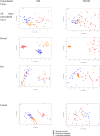Functional data geometric morphometrics with machine learning for craniodental shape classification in shrews
- PMID: 38971911
- PMCID: PMC11227550
- DOI: 10.1038/s41598-024-66246-z
Functional data geometric morphometrics with machine learning for craniodental shape classification in shrews
Abstract
This work proposes a functional data analysis approach for morphometrics in classifying three shrew species (S. murinus, C. monticola, and C. malayana) from Peninsular Malaysia. Functional data geometric morphometrics (FDGM) for 2D landmark data is introduced and its performance is compared with classical geometric morphometrics (GM). The FDGM approach converts 2D landmark data into continuous curves, which are then represented as linear combinations of basis functions. The landmark data was obtained from 89 crania of shrew specimens based on three craniodental views (dorsal, jaw, and lateral). Principal component analysis and linear discriminant analysis were applied to both GM and FDGM methods to classify the three shrew species. This study also compared four machine learning approaches (naïve Bayes, support vector machine, random forest, and generalised linear model) using predicted PC scores obtained from both methods (a combination of all three craniodental views and individual views). The analyses favoured FDGM and the dorsal view was the best view for distinguishing the three species.
Keywords: Functional data analysis; Geometric morphometrics; Landmarks; Linear discriminant analysis; Principal component analysis; Shrews.
© 2024. The Author(s).
Conflict of interest statement
The authors declare no competing interests.
Figures






Similar articles
-
Classification of Suncus murinus species complex (Soricidae: Crocidurinae) in Peninsular Malaysia using image analysis and machine learning approaches.BMC Bioinformatics. 2016 Dec 22;17(Suppl 19):505. doi: 10.1186/s12859-016-1362-5. BMC Bioinformatics. 2016. PMID: 28155645 Free PMC article.
-
The shrew tamed by Wolff's law: do functional constraints shape the skull through muscle and bone covariation?J Morphol. 2015 Mar;276(3):301-9. doi: 10.1002/jmor.20339. Epub 2014 Nov 11. J Morphol. 2015. PMID: 25385121
-
Geometric morphometrics and machine learning as tools for the identification of sibling mosquito species of the Maculipennis complex (Anopheles).Infect Genet Evol. 2021 Nov;95:105034. doi: 10.1016/j.meegid.2021.105034. Epub 2021 Aug 9. Infect Genet Evol. 2021. PMID: 34384936
-
[Principles and methods of geometric morphometrics].Zh Obshch Biol. 2002 Nov-Dec;63(6):473-93. Zh Obshch Biol. 2002. PMID: 12510587 Review. Russian.
-
Application of Machine Learning Approaches for the Design and Study of Anticancer Drugs.Curr Drug Targets. 2019;20(5):488-500. doi: 10.2174/1389450119666180809122244. Curr Drug Targets. 2019. PMID: 30091413 Review.
Cited by
-
Geometric morphometrics approach for classifying children's nutritional status on out of sample data.Sci Rep. 2025 Jan 31;15(1):3906. doi: 10.1038/s41598-025-85718-4. Sci Rep. 2025. PMID: 39890869 Free PMC article.
References
-
- Adams DC, Rohlf FJ, Slice DE. Geometric morphometrics: Ten years of progress following the ‘revolution’. Ital. J. Zool. 2004;71:5–16. doi: 10.1080/11250000409356545. - DOI
-
- Dujardin, J. P. Modern Morphometrics of medically important arthropods. in Genetics and Evolution of Infectious Diseases. vol. 2, 285–311 (Elsevier Inc., 2017).
-
- Moneva C, Torres M, Demayo C. Sexual dimorphism in the shell shape of the golden apple snail, Pomacea canaliculata (Lamarck) using geometric morphometric analysis. Egypt Acad. J. Biol. Sci. B Zool. 2012;4:39–46.
MeSH terms
Grants and funding
LinkOut - more resources
Full Text Sources

